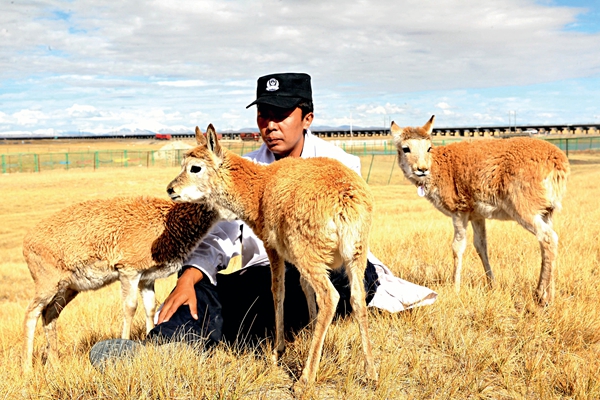The Tibetan Antelope
China Today by Jane Lu ,January 16, 2018 Adjust font size:

A staff member at Sanandaj Natural Protection Station in Hoh Xil strives to protect Tibetan antelopes.
Another cause is human encroachment on their habitats. The reclamation of uninhabited areas led to a reduced area for antelopes’ habitation. For instance, rare animals such as kiangs and Tibetan antelopes used to live in the uninhabited area – Shuanghu County on the northern Changtang Plateau. Since the mid-1970s, however, people came and turned it into pastures, disrupting hundreds of square kilometers of the ecological environment. Another example is the Ulan Ula Lake and Taiyang Lake in western Qinghai Province. After the discovery of gold mines, people flocked in and destroyed the primeval vegetation, making it increasingly difficult for Tibetan antelopes to survive.
However, the ultimate reason for the drastic decline of antelope population is human greed. Poachers rampantly kill the animals for hides, as the exceptionally fine and soft underfur can be woven into a luxury shawl – Shahtoosh. Illegal poachers usually smuggle the fur, called “soft gold,” to Nepal and India and finally to countries such as Italy and France. In addition, the pitch-black antlers of male antelopes are regarded a rare medical material, and the heads used to be a kind of fancy decorations, thus making antelopes a target for illegal hunters and smugglers. In May 2003, the police cracked a big case of armed poachers who killed more than 1,000 antelopes. According to incomplete statistics, about 20,000 antelopes were poached from 1980 to 2005. The life of antelopes was disturbed and breeding affected because of poaching.
In this connection, the Chinese government set up nature reserves, cracked down on poaching, and sought international cooperation in banning illegal trade of antelope fur products. In 1999, an international symposium on antelope protection and trade controls was held in Xining, capital of Qinghai Province. Representatives from seven countries including China, France, India, Italy, Nepal, and the U.K. reached consensus and issued The Xining Declaration.
In addition, numerous volunteers have participated in protection efforts by saving injured young antelopes, prohibiting illegal earth and sand digging, and raising people’s awareness of environmental protection. During migration season, staff and volunteers could be seen regularly near the Qinghai-Tibet Highway, stopping vehicles to allow the antelopes to cross. When the Qinghai-Tibet Railway was under construction, antelopes’ migration was given special attention. Thirty-three special passageways – with a width of one to two km – were built along the migration routes in Changtang Plateau and Hoh Xil. Thanks to years of anti-poaching efforts, the antelope population in Tibet has grown to 170, 000 at the end of 2012.
Jane Lu is a freelance writer in Beijing.